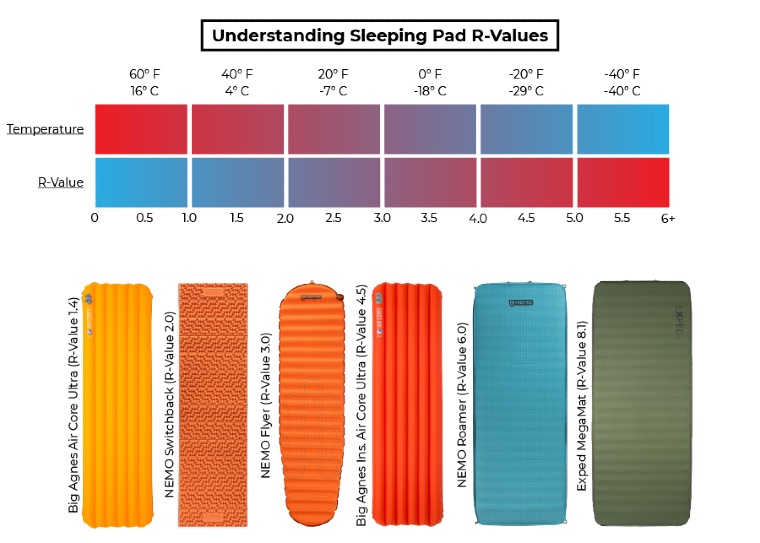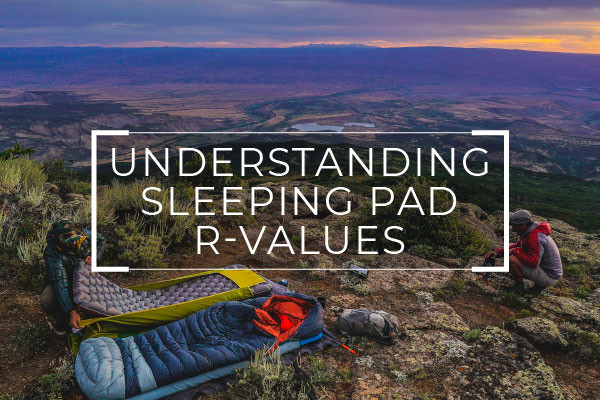Understanding Sleeping Pad R-Values
Posted by Dan Goodman on 15th Jul 2020
If you’ve spent any time looking at sleeping pads over the past few years, you’ve probably encountered the R-value along the way and didn’t know what to make of it. We can't blame you either. Until recently, R-value ratings weren’t standardized and were only given for some sleeping pads, meaning they didn’t hold much weight unless you were comparing two camping pads from the same company.
But in 2020, a standardization for the R-value was put into place by ASTM International to make it easy for consumers to compare the thermal efficiency of pads across different brands, meaning it’s time you learned what the R-value is, and what it can do for you.
What Is an R-Value?
Before getting too deep into R-value standards, it’s worth understanding what an R-value is and where it comes from. Most campers choose a sleeping mat based on features like weight, cushion, and ease of inflation. What many people forget, is that beyond putting a layer of cushioning in between you and the rocky ground, your sleeping pad also does a lot of work to insulate you from a cold sleeping surface. That’s where R-values come into play.
Sleeping pad R-values are a measure of thermal resistance, which is a fancy way of saying it’s a measure of how well a pad resists heat flow through it. Since you’re constantly transferring heat away from your body to your sleeping surface, you want a sleeping pad that resists heat flow, so you keep all of your hard-earned body heat close by.
How Are R-Values Measured?
The reason R-values have been shrouded in mystery for so many years is that there was no standardized method of measuring them. This led to many creating their own testing methods and some simply not supplying an R-value rating at all. But this year, that all changed. With the development of the ASTM standard, now more companies will be providing an R-value rating, and, like with sleeping bag temperature ratings, that will allow you to compare pads across different brands.
For the gear nerds among us, the test works by putting a sleeping pad in between two plates — a hot plate on top and a cold plate on the bottom. These plates work to simulate a warm-bodied camper on top and the cold, hard ground below. Over a period of four hours, these plates are measured to determine how much energy the top plate uses to stay at a consistent temperature of 35℃.
What R-Value Is Right For Me?
Staying warm while camping is a combination of the R-value of your camping mat, the temperature rating of your sleeping bag, and how warm or cold you naturally sleep. Thus, there are no hard and fast guidelines for knowing exactly what you need. But, there are a few general rules that will help you make a decision.
- A sleeping pad with a higher R-value is always a better insulator.
- R-values are additive, meaning that if you choose to stack a sleeping pad with a rating of 2.0 and one with a 4.0 rating, you’ll have a total R-value of 6.0.
- Most women sleep colder than most men, so female campers should consider opting for a pad with a higher R-value.
- When in doubt, go for a higher R-value if it falls within your price range. They tend to be more versatile and will seldom cause you to be too warm while camping.
- Slim, ultralight pads, built for fast and light backpacking, often have a lower rating than plush, self-inflating sleeping pads with lots of cushion.
Sleeping Pad R-Value Charts
Many companies also provide a rough guide to help consumers understand what R-values are suited to what types of camping. Unfortunately, there’s been no standardization process for these guides, but here’s our take:

This should give a general idea of where to start the process of buying a sleeping pad, but R-values do not directly correlate to temperature ratings as there are many factors that will affect your overall warmth including ground surface temperature, sleeping bag insulation, sleeping bag liners, clothes worn to bed, etc.
Is Everyone Using the New Standard?
The new ASTM standard is not a legal requirement, and brands could continue to post an R-value for their sleeping pads based on their own testing methods. But the good news is that if you see it marked as an ASTM R-value, you know exactly what you’re getting. As of 2020 here are a number of major brands whose currently published R-values are tested under this standard:
Conclusion
There are plenty of sleeping pads on the market that don’t have R-values associated with them, particularly older models, and it will take time for it to become a standard that every brand uses. With many brands introducing the ASTM Standard into their lines going forward, the R-value will hold considerably more weight over time. As such, it’s worth understanding what you’re looking at and knowing how to use these values to your advantage when comparing different sleeping pads.
About Campman
Campman is an outdoor retail store located in Salt Lake City, Utah that specializes in gear and equipment for camping, skiing, backpacking, climbing, and everything in between. We understand that the difference between a bad memory and the adventure of a lifetime can come down to the gear you take with you when you head outdoors, and we want our customers to have the best experiences possible. When it comes to getting outside, we get it, and we’ll get you the gear you need to get there.
Questions? Feel free to contact us by phone at (801) 999-8117 or by email at sales@campman.com.
Share on:


